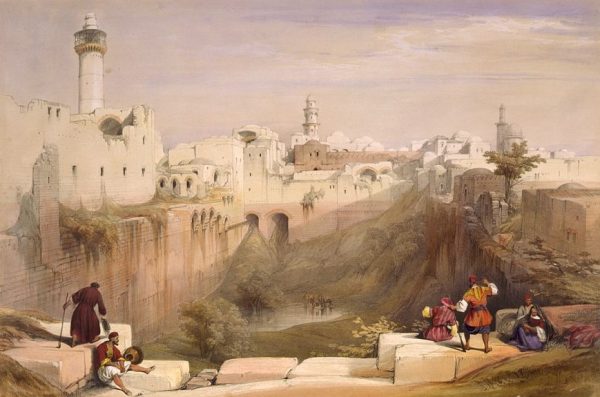The Pool of Bethesda
David Roberts was born in Scotland in 1796 (to give some historic context, that’s the year Tennessee became the 16th state). Roberts was the son of a cobbler. In his teens, he was apprenticed to a house painter. At age 20, he began working as a set designer and painter in theater. He worked in that profession in Edinburgh and Glasgow in Scotland and later in London. By his late 20s, he was exhibiting paintings in London.
In 1836 Roberts created some of the watercolor illustrations for Landscape Illustrations of the Bible by T. H. Horne. Having never been to the Holy Land himself, he based his watercolors on sketches other artists had created. Roberts became very interested in Bible lands. He traveled there himself in the spring of 1839 and stayed for a few weeks. Over the next few years, he published watercolor illustrations of scenes in the Middle East and North Africa in cooperation with lithographer Louis Haghe.
The illustrations were published a few at a time (which was the same way that John James Audubon originally published his Birds of America) until he had 247. Between 1842 and 1849, Roberts and Haghe published six popular volumes, entitled The Holy Land, Idumea, Arabia, Egypt, and Nubia. Both David Roberts and Louis Haghe became members of the Royal Academy of Art in London.
I learned all this last night after searching for April in the digital collection of prints and photographs in the Library of Congress. “Who are David Roberts and Louis Haghe?” I wondered. I found out on the Royal Academy website.
I love to see illustrations that people created in the Holy Land in the 1800s. Today I want to share with you The Pool of Bethesda.

In John 5, we learn that near the Sheep Gate in Jerusalem, there was a pool called Bethesda. The pool had elaborate architecture with five porticoes. I had to look that up. A portico is a colonnade or a covered walkway. Many sick, blind, limping, and paralyzed people lay in these porticoes. One of them had been ill for 38 years. Jesus saw him there one Sabbath day and asked him if he wanted to get well.
Jesus told the man to get up, pick up his pallet, and walk. Of course, that’s what the man did because Jesus can do astounding things.
As so often happened, the Jews saw the man carrying his pallet and told him he couldn’t be doing that on the Sabbath. The man told the Jews that the man who had made him well told him to do it. The Jews asked him who had said that, but the man didn’t know who Jesus was. By then Jesus had slipped away in the crowd.
Jesus found the man in the temple later and told him not to sin anymore so that nothing worse happened to him.
The man who had been healed after 38 years went and told the Jews that Jesus was who had made him well. Verse 16 of John 5, says:
For this reason the Jews were persecuting Jesus,
because He was doing these things on a Sabbath.
John 5:16
Two lessons come to mind:
- Again and again, Jesus suffered persecution for doing the right thing. We shouldn’t be surprised when the same thing happens to us. Jesus told us it would.
- We human beings can be fickle.
It’s hard to imagine someone who had been healed after being ill for 38 years tattling on Jesus and getting Him in trouble with the Jews. Jesus had told him not to sin anymore so that nothing worse happened to him. I think Jesus probably looked deeply into that healed man’s soul and knew that he needed healing that had nothing to do with getting up and walking away from the Pool of Bethesda.
Whatever you may be facing today, don’t forget that no matter what things may look like today, Jesus has overcome the world.
These things I have spoken to you
so that in Me you may have peace.
In the world you have tribulation,
but take courage; I have overcome the world.
John 16:33

